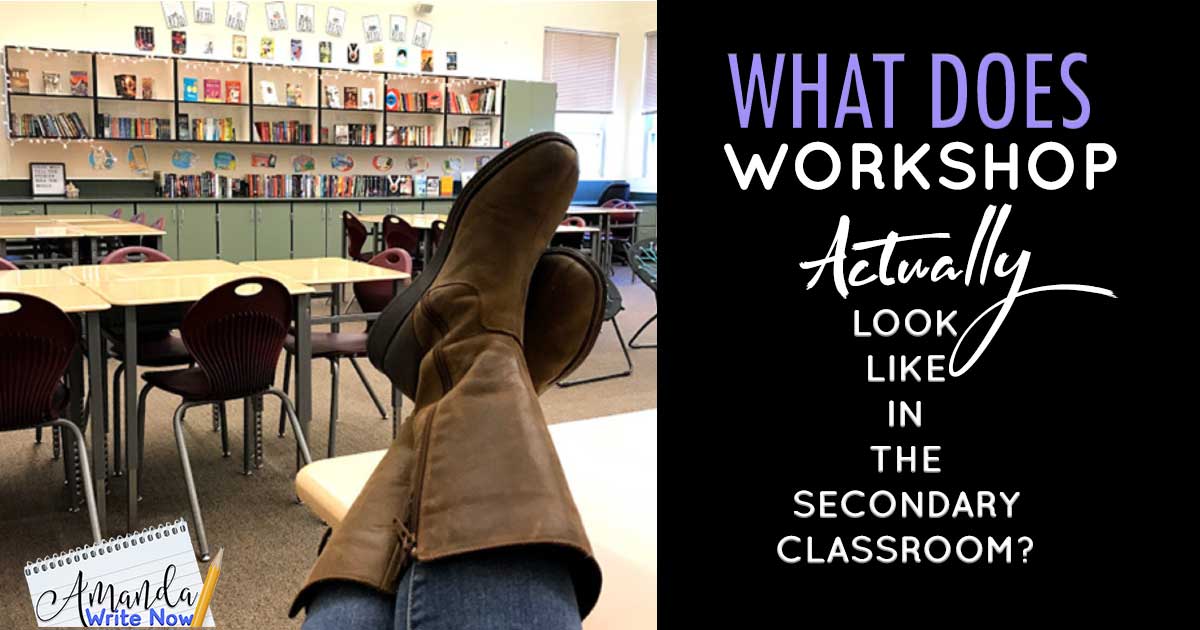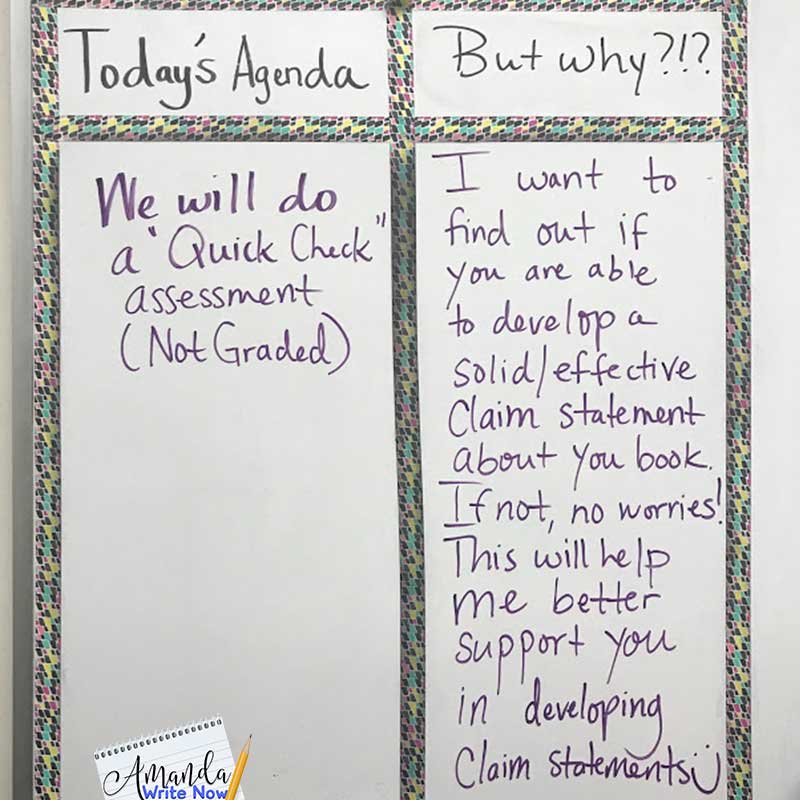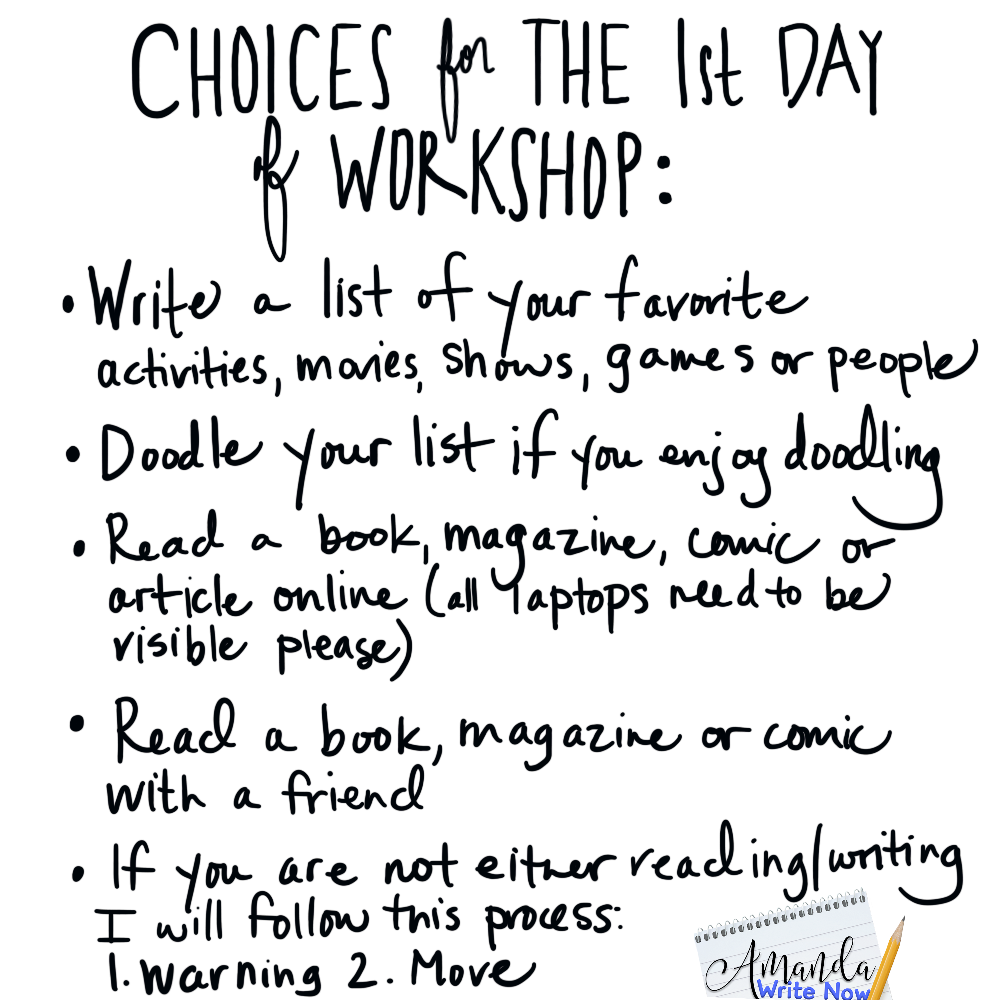 I get a lot of emails every week asking a wide range of questions. One question that seems to come up over and over again is, what does workshop actually look like in a secondary classroom?
I get a lot of emails every week asking a wide range of questions. One question that seems to come up over and over again is, what does workshop actually look like in a secondary classroom?
Here’s the simple answer: workshop can look however you want it to look.
You could choose to do workshop every day, once a week, for a month or for six months and then quit! It’s really up to you! It can look how you want it to look. That’s the beauty of being a teacher. We get to decide how our classroom runs. You can pick and choose what resonates with you and what could work for you.
In this post I’ll discuss what it looks like in my classroom but every teacher, school and student has different needs. But, you’re probably still wondering…what does this actually look like on a day-to-day basis? What about month-to-month? Keep reading to find out!
The Bell Rings…
I stand at the door and greet students. I try to make eye contact with every student. I try to make them laugh and smile. Some walk by and ignore me. If this happens I make sure to check in on them later. It’s important to me that each student feels cared for and seen.
First Ten Minutes…
This year I’m playing on using “quick writes” the first ten minutes of class. What are quick writes? They are excerpts from mentor texts that students have to respond to in some way or another. In The Quickwrite Handbook by Linda Rief (this is an Amazon Affiliate link, if you purchase this book I will get a small commission), there are 100 mentor text excerpts and for each excerpt there are 3-4 response options for students to choose from. I plan to have students do quick writes for a month and then independent reading the first ten minutes the next month. I’ll alternate between quick writes and independent choice reading for the first ten minutes all year.
Every one gets out a book. This is how I incorporate reading workshop into writing workshop. I know students are busy with after school programs, other classes, homework, family time, chores and spending time with friends. Students are busy! They don’t always have time or make time for reading. So I try to carve out time for them to do so in my classroom every day.
Students are expected to already have a book to read when they walk through my door. This reading time is not the time to be looking for a book in the class library. This is time to read. It’s valuable time, eyes need to be on print. I don’t like my students read online. Being prepared with a book is homework I require of students. I teach students about the best times to find a book in our class library: before school, during work time (when students are reading or writing after my mini lesson), if they finish their work early, the last five minutes of class, during nutrition break, during study hall or after school.
While students are reading I take attendance and have conversations with individuals about their books. If I notice a student isn’t really reading I’ll recommend another book to them.  I also try to incorporate a book talk. I’ll quickly summarize a book I’ve enjoyed reading in the past and entice students to read it. Then, I’ll say, “Who wants it?!?!” This can cause some fights over a book. If this happens I know the book talk went well. Sometimes I also have students do a book talk if we have time.
I also try to incorporate a book talk. I’ll quickly summarize a book I’ve enjoyed reading in the past and entice students to read it. Then, I’ll say, “Who wants it?!?!” This can cause some fights over a book. If this happens I know the book talk went well. Sometimes I also have students do a book talk if we have time.
After the ten minutes, I say, “Everyone finish the page you are on.” I want to respect that students might be in the middle of a page when it’s time to transition into the next phase of workshop. It’s interesting to pay attention to the students who slam their books shut or stop reading immediately after this one minute warning. These students probably need help finding a new more engaging book tomorrow.
Sometimes I also let students buddy read. Some students get really into reading when they get to buddy read!
The Meeting Area
 Once students have closed their books I say, “Okay everyone come to the meeting area.” I stand behind a document camera so that I can write in front of students, show part of a mentor text or a video. Once all students have their notebooks and are sitting at the meeting area I set my timer for ten minutes. This year I’m going to put this responsibility on students. This is so I don’t go over the time and students have an opportunity to actually write during the period. If I went over ten minutes students would have very little time to get to work on writing.
Once students have closed their books I say, “Okay everyone come to the meeting area.” I stand behind a document camera so that I can write in front of students, show part of a mentor text or a video. Once all students have their notebooks and are sitting at the meeting area I set my timer for ten minutes. This year I’m going to put this responsibility on students. This is so I don’t go over the time and students have an opportunity to actually write during the period. If I went over ten minutes students would have very little time to get to work on writing.
The Mini Lesson
The lesson usually starts with me asking students to turn to someone next to them and explain what they learned yesterday. This is called retrieval practice. Retrieval practice is a powerful method of getting students to retain the information they learned. It’s an opportunity to review and clear up any confusions. Next, I state my teaching point. This is an explicit statement about what students will learn today. The teaching point is also written on the board somewhere so students can see it. My agenda is separated into two parts, what we are doing and an answer to the question, “but why?”  I want to keep students’ attention during my mini lesson. I make a fool of myself trying to write or say something funny to make them laugh. This is all in an effort to engage them in the lesson.
I want to keep students’ attention during my mini lesson. I make a fool of myself trying to write or say something funny to make them laugh. This is all in an effort to engage them in the lesson.
Work Time
Once I’ve taught the mini lesson, I’ll direct students’ attention to the choice board for work time. A choice board is just a list of things students can be doing during work time. Often I’ll put a “must do” activity that is required and then “may do” activities that are optional activities after doing the required activity.  Then I set a timer for two minutes. I let students know that they have two minutes to find the materials they need, get to their spots, start following the noise level and get started on their work.
Then I set a timer for two minutes. I let students know that they have two minutes to find the materials they need, get to their spots, start following the noise level and get started on their work.
Every year I also teach my students noise levels. Sometimes it is silent work time if a publishing date is looming and students need to really crank out their drafts. Other times students may need to get help from each other or talk out their ideas because they are in a brainstorming phase of the writing process. During a reading unit, work time is usually silent because reading requires silence and individual attention. Students may also need support reading a class novel so I might pair them up with a buddy that they can read with. In these special cases I do allow talking.
Students are allowed to sit where they want during work time as long as they are focused. Allowing students to sit where they want is a great incentive to be productive. If they aren’t productive I follow a simple sequence of steps called a consequence sequence: warning/talk, move student, email family, meeting with student and family.
Conferences
Once everyone seems settled and on task I begin conferring with individuals about their work. I follow a very predictable and simple structure for conferences too! It goes something like this:
- Ask students what they are working on
- Praise one thing they are doing
- Ask students what they might need help with based on the rubric (this can pertain to a whole class novel unit or a writing unit)
- Provide one and only one tip
- Have students repeat back what they will work on now.
It should only last five minutes! I use my cell phone to time the conferences and students know that it can only last five minutes. So I can’t read their entire writing piece in that time. Instead I have students read excerpts of their piece based on what they most need help with. The key is to be among students during the entire work time session.
Closure
Students talk to a partner, share a piece of writing, an insight from their novel, a goal for the next day, self-assessment, an exit ticket. The exit Write one way you could get help from a mentor text or what is a mentor text?
Clean Up
I give students plenty of time to clean up and pack up. I urge them not to hang out by the door. Instead I ask them to chat with friends near their desk or in other areas of the class if we have extra time before the bell rings. During this time I am checking that they actually cleaned and if not I call students over to pick up trash and push chairs in.
A Month of Workshop?
My units last three to four weeks and don’t always end with a big publishing party. Sometimes units end with a class discussion or a reflection sheet or a self-assessment.
I don’t feel like units always have to end with some huge project. That is overwhelming, especially if your units only last 3-4 weeks. Having to grade a big project or writing assignment every three to four weeks is way too much grading.
My school year is organized in units. I alternate reading and writing units but I also try to demonstrate the intertwined nature of reading and writing. I believe the key to doing this is by using mentor texts. So, if students are about to write informational articles or write a TED Talk speech they should first spend a few weeks reading and analyzing these types of writing genres before you begin your writing unit and students start attempting their own articles or speeches. Below you will find the units that teachers that are part of my membership program receive the first of every month. If you’re interested in joining my membership program click here.
August: Launching Reading & Writing Workshop
September: Reading & Writing Fiction
October: Reading & Writing Narratives/Memoirs
November: Reading & Writing Information
December: Research, Inquiry & Essential Questions
January: Literary Analysis Writing & Book Clubs
February: Reading & Writing Arguments
March: Reading & Writing Speeches
April: Reading & Writing Poetry
Wrap Up
Workshop can be simple and make your life so much easier! Teachers work hard and need to simplify things for themselves. If you want easy to follow lessons delivered to your inbox the first of every month then I highly recommend you become a Workshop Teacher Member! Sign up above to attend my next online training and learn all about the program.

0 Comments